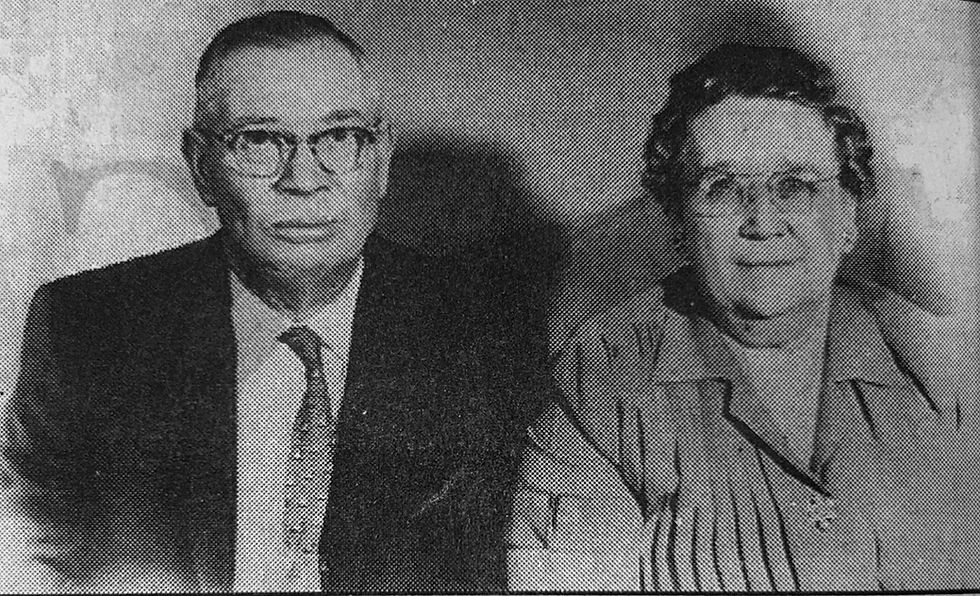Recollections: Legends of Yesterday - Casey Jones Continued
- gvnews7
- Jun 10, 2024
- 4 min read
This is a reprint of original articles by Hugh Woolley, a longtime resident and community leader of Graceville. Woolley published these articles in The Graceville News more than 20 years ago.
Originally published in the May 31, 2001 edition of The Graceville News.
It is estimated by some railroad men that Casey Jones, on some of the straight flats, might have run his engine close to 100 mph. He had to be close to that speed to have made up that time. When he passed through Durant, he was only eight minutes late. When he wrecked at Vaughan, MS, which was 15 miles from Canton, MS, his destination, he was only two minutes behind schedule. While rolling toward Vaughan the stage was being set for Casey's tragic wreck.

Freights #72 and #83 were both on the sidetracks and they were so long that they had a few cars and caboose on the main line. What they intended to do was a saw-by. This procedure is meant to pull one end of the long freight train out on the main line to clear the north switch. The passenger train with six to eight cars would then be able to pull past the first switch and stop. Then the long freight train would back up clearing the main line for the passenger train to proceed on. However, an air brake hose broke, and the caboose and few cars were stuck on the main line above the north switch. The rear is what Casey plowed in to. The freight had a flagman up the track with his lantern, but he failed to gain the engineer's attention. It is thought by some railroad men that Casey was running steam through his engine so fast that he was busy helping the fireman shovel the coal. Immediately afterwards the torpedoes went off and they saw a caboose up ahead. It is believed that Casey told Sim Webb to jump.
Casey, like a faithful captain on a sinking ship, stayed at his post and did four things in a matter of seconds. He reversed his engine, applied his brakes, pulled his sandsifter, and pulled his whistle wide open and almost had his engine under control. It's estimated that he was doing about 75 miles per hour when he saw the caboose, he then derailed and turned over and his engine was facing north, the way he was coming. Casey was the only fatality from the wreck.
I have been to Vaughan where it actually happened. Many railroad engineers died like Casey and were casually mentioned in the newspaper, but Casey became a hero among the people. He had made a record run and saved all his passengers by staying with his engine. He might could have jumped after he had performed all the emergency tasks, but he didn't. It is possible that Casey could have escaped the hero's image had it not been for Wallace Saunders, a black engine wiper or oiler from Canton, who wrote the original ballad and sang it around Canton. It took, and became famous throughout the nation, even made Vaudeville in Chicago and New York.
The legend was 36 or 37 years old and he was born about the same time as my father, 1864, during the Civil War. The total cost to the railroad in dollars was less than $3400 including the engine, cars, and caboose repairs. The settlement looked similar to the following: Sim Webb-bruises. $5; two postal clerks- jarred, $1 each; William Miller- Express messenger, injuries to the back. apparently slight, $25; Mrs. William Delo-slight bruises, left knee, not settled.
I have passed through Jackson, TN, but I did not know about the Casey Jones Museum which was the home of Casey and his family. It is just down the street from the Illinois Central Railroad, also near the passenger depot. This is near the home of Dick Wheatley, my former boss man. He told me that his father was a railroad man and knew a lot about John Luther Jones. The Illinois Central Railroad also passed near the home of Jerry Clower's home at Liberty, MS. Jerry told me one time no grass grows on that main line.
I remember a special engineer who drove trains on the M & O through our back forty, he was noted for his whistle blowing. He could make the hair stand up on the back of your neck when he played that lonesome hobo call. Other engineers would try to imitate him, but none could do it like Billy Frekles.
I also remember the freight trains that use to run through our farm during the Great Depression in the late 20's or early 30's. Sometimes there would be over 30 hobos on one train. They were trying to beat the system, some seeking work in other parts of the nation. Most of them were broke and the railroad often turned their head when looking at the free riders or bums.
I used to envy my oldest half-brother who was a machinist in Tuscaloosa, AL . He knew most of the train men by first names. Many times, I would go with him to catch a train back to Tuscaloosa, he would step in the cab and ride with the engineer and fireman.
Thanks to the following for information from the Internet: Sharon Taylor, Pat and Dawn Woolley, Larry Graham, and Curtis Walker, railroad magazine clippings.
To Subscribe To The Graceville News Visit Pricing Plans.





Comments